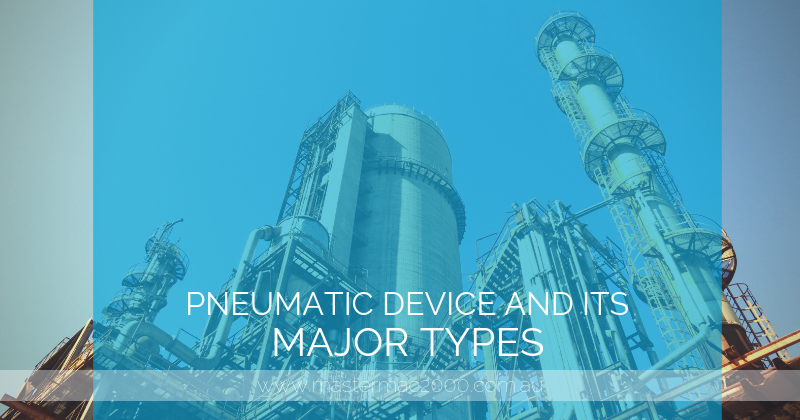Pneumatic Device and Its Major Types

Any instruments or tools that create and make use of compressed air are called pneumatic devices. Such devices include atomisers, blast cleaners, forging presses, pavement breakers and riveters.
The power of compressed air is found to be economical, flexible, and safe. Air devices don’t create spark hazards in explosive atmospheres, given that they can be used under wet conditions without the risk of electric shock. No return lines are needed as a relatively small compressor already suffices in filling a storage tank for irregular use. There are other characteristics of compressed air systems that are important in order to meet special service requirements.
Devices such as valves, cylinders, or pistons can be easily connected to another with the use of flexible hoses, pipes, or tubings. WIth a simple manipulation of valves, many actions can be controlled. With no shock, an actuation piston’s motion in a cylinder can be altered in an instant in just small steps. This is due to the air systems’ ability to provide great flexibility in motion control and speed. In the case of relief valves, they can be arranged with ease in order to protect an existing system from damages.
Operation controls are centralised, efficient, and simple. With this, air systems own few moving parts that contribute to low maintenance costs and high reliability.
Principal classes of pneumatic devices
What constitutes the major types of pneumatic devices are air compressors and pneumatic tools. And to name a few of the other kinds of apparatus included are train brake systems, paint-spray equipment, air rams, and pneumatic tubes used in transferring materials.
Air compressors are power-driven machines that are utilised in compressing air, which works from initial intake pressures that are usually atmospheric to higher pressures. They can be classified into two types that depend on the action of the air or fluid, namely the velocity or dynamic type and positive-displacement.
- In the dynamic type of compressors, the following are its subdivisions.
- axial-flow type – the type of which the flow primarily follows through a rotor or rotating runner in a radial direction
- centrifugal type – the type of which the flow primarily follows through a runner in the direction parallel the rotation’s axis.
- fluid-jet type
- The static-pressure or positive-displacement type can be identified through its action characterised by a displacement or volumetric action. By reducing the volume of the space, the pressure will be increased, and the air with successive volumes are constricted within a closed space.
Pneumatic tools can be divided into two categories that are based on the driving method, specifically the reciprocating piston and rotor, both of which are known to be air motors.
- Rotating type of compressors operate in reverse, serving as one type of motor. How does it work? The central shaft or spindle rotates once compressed air enters the housing, which then pushes on the vanes. What is fastened to the spindle is a grinding wheel, a drill, or another device.
- As for the reciprocating-piston compressor, it operates in reverse and functions as a motor. Once compressed air enters the cylinder, it will expand and force the piston to move. And on the other side of the piston, the return stroke caused by the move may be actuated by the compressed air or by spring action. Tools such as a riveting hammer can be used to connect to the reciprocating piston.
If you want to learn more about air compressors or pneumatic tools, contact Mastermac2000.com.au today!

About MasterMac2000: Your Trusted Pneumatic & Process Automation Partner.
LEADING THE INDUSTRY: Established in 1989, MasterMac2000 has grown to become one of Australia's largest privately owned pneumatic and process automation companies. We stock top-quality brands like Univer, Mack, Tolomatic, Mac, Piab, American, and Rotoflux in Brisbane.
SERVING QLD & NORTHERN NSW: We proudly service Queensland and Northern New South Wales for all your pneumatic and process equipment needs. Our mission is to provide the best pre and post-sales support while actively expanding our client base.
SOURCING HARD-TO-FIND PARTS: Not only do we stock quality components, but we also excel at sourcing those elusive, hard-to-find parts. With our extensive database and global network of contacts, getting the parts you require is as easy as a call to our highly skilled, professional sales team.
DEDICATED TO YOUR SUCCESS:
- Decades of expertise in pneumatics & process automation
- Carefully curated selection of world-class brands
- Exceptional sourcing capabilities for speciality parts
- Knowledgeable sales staff dedicated to finding solutions
- Unwavering commitment to customer service excellence
About The Author
Stuart Havill
Stuart Havill is the owner and manager of MasterMac2000, Queensland's largest privately owned pneumatic and process valve company.
With his early working career as a maintenance fitter for Boral in 1992, Stuart has spent his life in the field of pneumatics and process equipment. He gained extensive experience in plant design, maintenance, repairs, fabrication, and site management.
In 1996, he transitioned to a pneumatic sales technician role at MasterMac2000, where he excelled in key account management, providing cost-effective solutions, and managing a sales team of 9 employees.
Since 2002, Stuart has been the manager at MasterMac2000, overseeing the company's growth and establishing it as a leader in pneumatic automation and process valve engineering. His expertise spans customer training, CRM setup, industrial compressor sizing and installation, and turn-key project management.
Under Stuart's leadership, MasterMac2000 has been servicing the industry since 1988, with 5 full-time sales representatives covering northern rivers NSW, Queensland, Northern Territory, and PNG. The company prides itself on providing the best-priced solutions to all customers in the marketplace.
View Stuart’s LinkedIn profile to learn more about his expertise in pneumatics and process equipment.